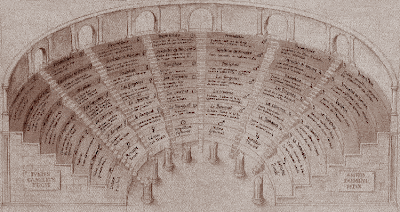While several proposed interesting ideas about the influence of the virtual domain upon the physical domain, I still feel my work lacks depth. It feels like I'm yet to scrape the surface of what I'm really dealing with architecturally. My understanding of the site was enhanced by a recent visit to St Albans and attempting to draw spatially how I understand the landscape from numerous frames of reference. Perhaps this is the key. The ability for the image to be comprehended in a multitude of ways from a variety of perspectives, both physically and metaphysically. Wertheim cites the Memory Theatre by Giulio Camillo and the Apple desktop working in similar ways, but enabling the processing of complex ideas into simple structured 'spaces' associated with memorable images or motifs.

Image courtesy of: http://www.spamula.net/blog/i05/camillo.gif
From a glance, the theatre displays reminders of numerous ideas associated collectively with their location spatially and virtually through their alignment to a particular planet. It enables complex subjects to be memorised and arranged for future consultation, in a structure akin to the ordering of the world wide web or contemporary filing systems.
Maybe this ordering of memories and images reflects how we navigate through familiar landscapes. It becomes our means of orientation, through place and through our own thoughts. We assign images fused into our heads that are attributed to greater memories. Some of these remain in the subconscious realm of our psyche, until triggered by similar images encountered throughout our daily lives. The strength of the image ingrained in our minds will determine the degree to which past experiences are recalled. Could we create environments that can orientate one in the future by creating powerful images in the present? Perhaps this isn't the direction my project will take, but a thought nonetheless.
So how can the project progress in the physical? I.e. stop writing and start creating and drawing. The relationship between St Albans and Verulamium is interested. The Roman city is abandoned. The exposed relics become sites that represent the trauma of citizens as the city fell and the paganist traditions were dismantled.

Photo of the Verulamium walls (South) and the London Gate, Ali Abbas 2009
Extraordinarily, the town relocates as one ideological system supersedes another. Should settlements be nomadic? What becomes of decadent components of an old city? In the case of St Albans, they represent an old culture. One that for 400 years outlawed alien beliefs, so much so that Alban was martyred for practising Christianity. Verulamium seems forgotten, hidden beneath layers of history. Small parts are uncovered and framed by iron railings. These frames become the only reference points for inquiry into the past. One navigates between them, and they project onto the landscape reference points for the hidden city. Why was the city never redeployed as a second settlement, or as a new built function. The contemporary use of the site as a park, described as the 'lungs of the city', becomes a vital place for people to escape the stresses of the city. Escaping contemporary St Albans and effectively arriving back in Verulamium. The new Verulamium...

